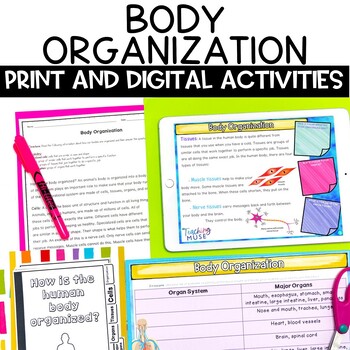Human Body Systems Organization
- Google Drive™ folder

What educators are saying
Also included in
- This human body systems unit of lessons and activities is a bundle designed to save you precious prep time as you teach students using the following materials: guided science texts, hands-on activities, review activities, classroom posters, graphic organizers, internet research activities, review shPrice $34.50Original Price $54.25Save $19.75
- Introduce the human body systems to your students using this bundle of print and Google Slide science reading worksheets. Your students will read to learn about the parts, function, how each body system works, and collaborates to maintain a healthy body. The human body systems bundle includes printPrice $30.00Original Price $39.50Save $9.50
Description
Teach students how the human body is organized using these print or digital materials. Students will learn about the four levels of human body organization; specialized cells, tissues, organs, and organ systems. Students will demonstrate their knowledge through comprehension questions, a graphic organizer, and the review activity.
Like this lesson on human body organization? Click here to see the human body unit and save 20%.
Students will learn:
- How the body is organized
- specialized cells
- tissues
- organs
- organ systems
- definition and examples of each
This body organization lesson includes:
- Step-by-step instructions on using the Google Slides version with tips.
- Two-page printable science text with three additional pages of comprehension activities
- Digital Google Slides version for students to access.
- Review flipbook activity
- Answer key
How to use this activity in your classroom:
- Introduce the human body systems: Students will learn that the human body comprises cells, tissues, organs, and organ systems. After learning this information, students can learn about the different human body systems.
- Sub plans: Everything is set up so that a substitute can easily teach the information to your students.
- Science station: Students can learn about the levels of organization in collaborative groups.
- Homework assignment
- Struggling learners: Visuals help struggling learners better understand the information.
Feedback from happy teachers:
- This is just perfect! Body systems are in my 5th grade Science text, and I am looking forward to adding this to our unit!
- Extremely helpful! Thanks for including the answers.
- I used the flipbook and article as an intro to human body systems in my high school special ed biology class. The kids were able to do this (almost) independently, and we've referred to it frequently throughout the unit.
- Thank you for sharing this resource! This was a big help when I introduced body organization and the body systems in class. It was a great tool to use to get the students thinking. Thank you for providing this for us.
Other lessons and activities you might be interested in:
- Skeletal
- Muscular
- Digestive
- Circulatory
- Integumentary
- Respiratory
- Excretory
- Nervous
- Endocrine
- Reproductive
- Immune
- Homeostasis
Kindly Note: If you have questions, do not hesitate in emailing me at Teaching Muse Email
PLEASE PREVIEW BEFORE PURCHASING
____________________________________________________________________________________
Thank you for visiting Teaching Muse. I would love for you to become a follower.
Teaching Muse followers receive new product information and discounts on any new items!
____________________________________________________________________________________
All rights reserved by Teaching Muse. This product is to be used by the original downloader ONLY. Copying for more than one teacher, classroom, department, school, or school system is prohibited. Additionally, this product may not be distributed or displayed digitally for public view. Failure to comply is a copyright infringement and a violation of the Digital Millennium Copyright Act (DMCA). Intended for classroom and personal use ONLY.







